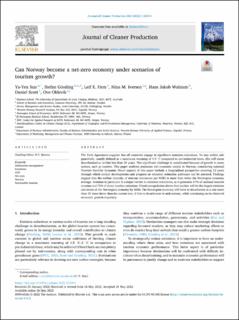| dc.contributor.author | sun, ya-yen | |
| dc.contributor.author | Gössling, Stefan | |
| dc.contributor.author | Hem, Leif Egil | |
| dc.contributor.author | Iversen, Nina Marianne | |
| dc.contributor.author | Walnum, Hans Jakob | |
| dc.contributor.author | Scott, Daniel | |
| dc.contributor.author | Oklevik, Ove | |
| dc.date.accessioned | 2022-08-04T13:27:09Z | |
| dc.date.available | 2022-08-04T13:27:09Z | |
| dc.date.created | 2022-06-05T09:48:34Z | |
| dc.date.issued | 2022 | |
| dc.identifier.citation | Journal of Cleaner Production. 2022, Volume 363 | en_US |
| dc.identifier.issn | 0959-6526 | |
| dc.identifier.uri | https://hdl.handle.net/11250/3010189 | |
| dc.description.abstract | The Paris Agreement suggests that all countries engage in significant emission reductions. To stay within safe guardrails, usually defined as a maximum warming of 1.5 °C compared to pre-industrial times, this will mean decarbonisation within less than 30 years. This significant challenge is complicated because of growth in some sectors, such as tourism. This paper analyses emissions and economic output in Norway, considering national Tourism Satellite Accounts. Novel aspects of this paper include a longitudinal perspective covering 12 years through which critical developments and progress on emission reduction pathways can be assessed. Findings suggest that the carbon intensity of tourism (emissions per NOK) is more than twice the Norwegian economy average. Aviation in particular is a major barrier to emission reductions, as it generates 17% of national tourism revenue and 75% of direct tourism emissions. Trend extrapolation shows that tourism will be the largest emission sub-sector of the Norwegian economy by 2030. The Norwegian economy will have to decarbonise at a rate more than 30 times faster than its current rate, if it is to decarbonise to mid-century, while continuing on its observed economic growth trajectory. | en_US |
| dc.language.iso | eng | en_US |
| dc.publisher | Elsevier | en_US |
| dc.rights | Attribution-NonCommercial-NoDerivatives 4.0 Internasjonal | * |
| dc.rights.uri | http://creativecommons.org/licenses/by-nc-nd/4.0/deed.no | * |
| dc.subject | Destination management | en_US |
| dc.subject | Emissions | en_US |
| dc.subject | GDP | en_US |
| dc.subject | Net-zero | en_US |
| dc.subject | Norway | en_US |
| dc.subject | Sustainable tourism | en_US |
| dc.title | Can Norway become a net-zero economy under scenarios of tourism growth? | en_US |
| dc.title.alternative | Can Norway become a net-zero economy under scenarios of tourism growth? | en_US |
| dc.type | Peer reviewed | en_US |
| dc.type | Journal article | en_US |
| dc.description.version | publishedVersion | en_US |
| dc.rights.holder | The Authors | en_US |
| dc.source.pagenumber | 9 | en_US |
| dc.source.volume | 363 | en_US |
| dc.source.journal | Journal of Cleaner Production | en_US |
| dc.identifier.doi | 10.1016/j.jclepro.2022.132414 | |
| dc.identifier.cristin | 2029568 | |
| cristin.ispublished | true | |
| cristin.fulltext | original | |
| cristin.qualitycode | 2 | |

